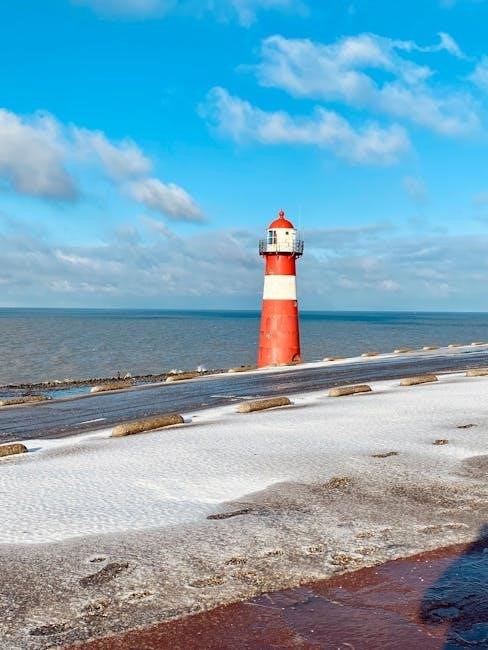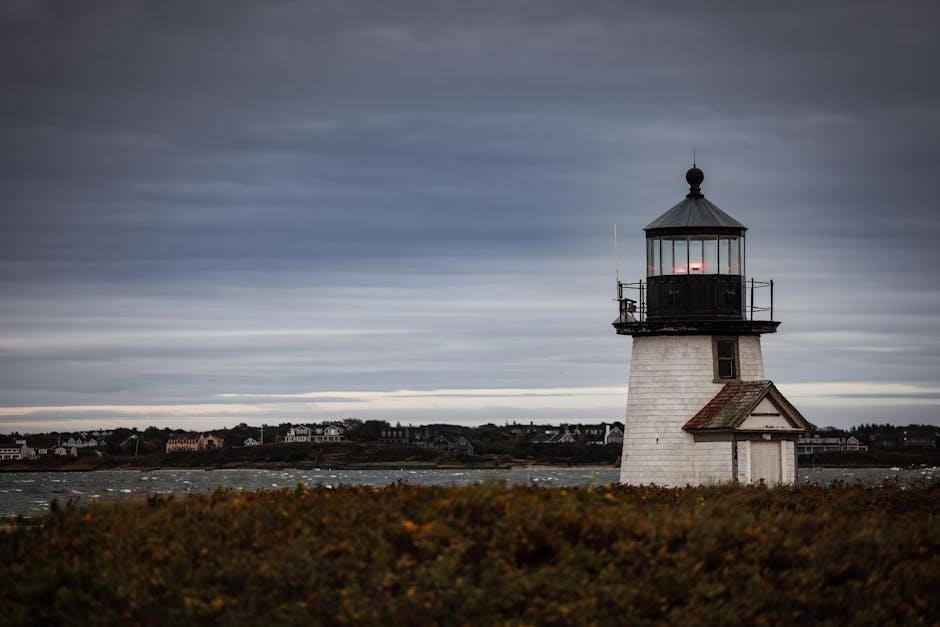White water rafting is an exhilarating outdoor activity that involves navigating inflatable rafts through rough‚ choppy river waters. It combines teamwork‚ adventure‚ and a deep connection with nature‚ offering thrilling challenges for both beginners and experienced enthusiasts. The sport demands physical effort‚ strategic thinking‚ and a willingness to embrace the unpredictable power of rivers.
What is White Water Rafting?
White water rafting is an exhilarating adventure sport that involves navigating an inflatable raft through rough‚ turbulent river waters. Participants use paddles to propel and steer the raft‚ working as a team to overcome obstacles. The raft is designed to be durable and buoyant‚ ensuring stability even in choppy conditions. This activity is suitable for a wide range of skill levels‚ from beginners to experienced rafters‚ and offers a unique way to connect with nature while experiencing adrenaline-pumping thrills. The goal is to maneuver through rapids‚ avoid hazards‚ and reach the end of the course safely. It combines physical effort‚ strategic thinking‚ and teamwork‚ making it a popular choice for outdoor enthusiasts seeking adventure and camaraderie.
Brief History of White Water Rafting
Brief History of White Water Rafting
White water rafting traces its origins to ancient civilizations that relied on rivers for transportation and survival. Early rafting involved simple‚ makeshift vessels crafted from materials like wood and animal hides. The modern version emerged in the mid-20th century‚ gaining popularity as an adventurous recreational activity. Inflatable rubber rafts‚ introduced during World War II‚ revolutionized the sport‚ offering durability and maneuverability. The 1970s and 1980s saw the rise of commercial rafting trips‚ making it accessible to the public. The sport gained international recognition with the establishment of competitions and governing bodies‚ solidifying its place as a thrilling outdoor pursuit. Today‚ white water rafting is enjoyed globally‚ blending excitement‚ nature‚ and teamwork.
Popular White Water Rafting Destinations
White water rafting enthusiasts flock to iconic rivers worldwide for thrilling experiences. The Colorado River in the Grand Canyon‚ USA‚ offers legendary rapids amidst breathtaking landscapes. Africa’s Zambezi River‚ bordering Zambia and Zimbabwe‚ is renowned for its intense Class IV and V rapids. Chile’s Futaleufú River is celebrated for its turquoise waters and challenging runs. In Asia‚ Nepal’s Trishuli River provides stunning Himalayan views and electrifying rapids. New Zealand’s Kaituna River is famous for its 7-meter Tutea Falls‚ the world’s highest commercially rafted waterfall. These destinations attract adventurers seeking unforgettable journeys through nature’s raw power and beauty.

Safety Tips and Precautions
Safety is paramount in white water rafting. Always wear proper gear‚ understand river conditions‚ and follow guide instructions. Assess risks and stay alert to avoid accidents.
Essential Safety Gear
White water rafting requires specific safety gear to ensure a secure experience. A properly fitting life jacket is crucial for flotation and protection. A helmet protects the head from impact with rocks or the raft. Paddles with sturdy shafts are essential for navigation. Wetsuits or dry suits provide thermal insulation in cold water. Secure‚ water-friendly footwear prevents slipping. A first aid kit is vital for treating injuries. Additional gear includes throw bags for emergencies and a whistle for signaling. Always inspect equipment before use and ensure it meets safety standards. Proper gear significantly reduces risks and enhances the overall safety of the rafting experience.
Understanding River Classification
Understanding river classification is critical for assessing the difficulty and safety of white water rafting. Rivers are categorized into six classes‚ from Class I (calm‚ flat water) to Class VI (extreme‚ nearly impassable). Class I features slow-moving water with minimal obstacles‚ ideal for beginners. Class II introduces small waves and mild rapids‚ requiring basic paddling skills. Class III involves larger waves‚ stronger currents‚ and tighter maneuvers‚ suitable for intermediate rafters. Class IV presents challenging rapids‚ complex obstacles‚ and precise navigation‚ recommended for experienced participants. Class V is extreme‚ with violent rapids‚ steep drops‚ and significant hazards‚ demanding advanced skills and physical conditioning. Class VI is considered unrunnable due to severe risks. Knowing the classification helps in selecting trips according to skill levels‚ ensuring a safer and more enjoyable experience.
Common Hazards and How to Avoid Them

Common hazards in white water rafting include strong currents‚ underwater obstacles‚ and collisions with rocks. To avoid these‚ always wear proper safety gear‚ stay alert‚ and follow guide instructions. Capsizing is a risk‚ but knowing self-rescue techniques can minimize danger. Avoiding collisions with rocks requires precise navigation and quick reflexes. Swimming in strong currents can be dangerous‚ so staying calm and floating on your back is essential. Understanding river dynamics and potential hazards beforehand enhances safety. Proper training and experience also play a crucial role in mitigating risks and ensuring a safe‚ enjoyable rafting experience.
Choosing the Right Trip
Choose a trip based on your skill level‚ experience‚ and preferences. Assess the river’s difficulty‚ guide expertise‚ and group dynamics to ensure a safe and enjoyable experience.
How to Select a Trip Based on Skill Level
Selecting the right white water rafting trip requires evaluating your skill level and experience. Rivers are classified from Class I (calm) to Class V (extreme). For beginners‚ Class I-II rivers are ideal‚ offering gentle currents and minimal obstacles. Intermediate rafters can handle Class III rivers‚ which feature stronger currents and more challenging rapids. Advanced rafters typically pursue Class IV-V rivers‚ which demand precise maneuvering and physical endurance. Always consult with experienced guides to ensure the trip aligns with your abilities. Starting with easier trips allows you to build confidence and skills‚ gradually progressing to more challenging routes as you gain experience. Prioritize safety and enjoy the adventure!
What to Expect on Your First Rafting Trip
Your first white water rafting trip will be an exciting mix of adventure and learning. Upon arrival‚ you’ll receive an orientation and safety briefing from your guide. They’ll explain proper paddling techniques‚ how to navigate the raft‚ and what to do in case of an emergency. Once on the water‚ you’ll experience a mix of calm stretches and thrilling rapids. The guide will direct the team‚ ensuring everyone works together to maneuver through obstacles. Be prepared for getting wet‚ as splashing is part of the fun! The trip will vary in intensity depending on the river’s classification‚ but the focus will always be on teamwork‚ safety‚ and enjoying the scenic beauty around you. By the end‚ you’ll feel a sense of accomplishment and likely be eager to return for more adventures!
Techniques and Strategies
Mastery of paddling strokes‚ understanding river currents‚ and precise teamwork are crucial. Adaptability to changing conditions and strategic maneuvering ensure a safe and successful rafting experience.
Basic Paddling Techniques
Mastering basic paddling techniques is essential for controlling the raft and navigating rivers effectively. The forward stroke propels the raft by dipping the paddle blade into the water at a 45-degree angle and pulling it back. The reverse stroke slows or stops the raft‚ while the sweep stroke helps in turning by extending the paddle outward. The draw stroke moves the raft sideways‚ aiding in lateral movement. Proper grip‚ body positioning‚ and timing are critical for efficient paddling. Team coordination ensures synchronized strokes‚ enhancing maneuverability. Practicing these techniques builds muscle memory and improves responsiveness on the water‚ making rafting safer and more enjoyable for everyone on board.
Navigating Rapids and Obstacles
Navigating rapids and obstacles requires a combination of strategy‚ awareness‚ and quick reflexes. Reading the water is crucial—identifying currents‚ eddies‚ and potential hazards like rocks or fallen trees. Paddlers must work in unison‚ following the guide’s instructions to maneuver the raft effectively. Forward and reverse strokes help maintain stability‚ while draw and pry strokes assist in avoiding collisions. Communication is key; shouting commands ensures everyone reacts swiftly. If the raft capsizes‚ staying calm and following safety protocols‚ such as swimming to the surface and floating on your back‚ is essential. Always wear a properly fitting life jacket and helmet to minimize risks. Teamwork and focus are vital for safely navigating challenging river sections.
Physical and Mental Requirements

White water rafting demands physical strength‚ endurance‚ and mental focus. It requires courage‚ teamwork‚ and the ability to stay calm under pressure for a safe experience.
Physical Conditioning for Rafting
Physical conditioning is crucial for white water rafting‚ as it involves intense paddling‚ rapid movements‚ and enduring rough conditions. Building strength‚ especially in the core‚ arms‚ and shoulders‚ is essential for maneuvering the raft. Cardiovascular fitness and endurance are also vital to sustain energy levels during long trips. Flexibility and balance help in maintaining stability on the raft‚ while overall physical fitness reduces the risk of fatigue and injury. Regular exercises like swimming‚ cycling‚ and strength training can prepare the body for the demands of rafting. Ensuring good physical health beforehand enhances safety and enjoyment on the water.
Mental Preparation and Teamwork
Mental preparation is vital for white water rafting‚ as it requires focus‚ calmness‚ and the ability to stay composed under pressure. Building confidence and overcoming fear of the unknown is essential. Teamwork is the backbone of rafting‚ as synchronized efforts ensure smooth navigation. Effective communication and trust among crew members are critical to respond to challenges swiftly. A positive mindset helps in adapting to unpredictable river conditions and enhances problem-solving skills. Pre-trip discussions and understanding roles within the team foster unity and coordination. Mental resilience and teamwork together create a harmonious and safe rafting experience‚ turning challenging rapids into achievable adventures.

Environmental Impact and Etiquette
White water rafting requires minimizing environmental impact by avoiding waste‚ preserving natural habitats‚ and respecting ecosystems. Etiquette involves leaving rivers pristine and promoting sustainable outdoor activities responsibly.
Leave No Trace Principles
Adhering to Leave No Trace principles is crucial for preserving the natural beauty of white water rafting destinations. These guidelines emphasize minimizing environmental impact by disposing of waste properly‚ avoiding disturbance of wildlife‚ and refraining from removing plants or rocks. Rafters should stay on designated trails to prevent erosion and respect cultural or historical sites encountered along the river. Additionally‚ avoiding the introduction of invasive species and minimizing the use of natural resources like water and fire are key practices. By planning ahead and being mindful of these principles‚ rafters ensure that future generations can enjoy the same pristine environments. Sustainable rafting begins with responsible behavior.
Respecting Local Ecosystems
Respecting local ecosystems is vital when engaging in white water rafting. Rafters should avoid disrupting wildlife habitats by keeping noise levels low and maintaining a safe distance from animals. It’s important to avoid littering and ensure all trash is properly disposed of after the trip. Additionally‚ rafters should not remove plants‚ rocks‚ or other natural elements from the riverbanks‚ as this can harm the local environment. Being mindful of sensitive habitats‚ such as spawning areas for fish or nesting sites for birds‚ is also essential. By preserving these ecosystems‚ rafters help maintain the beauty and biodiversity of the rivers they enjoy.
White water rafting offers thrilling adventures and lasting memories by emphasizing safety‚ teamwork‚ and environmental respect. Embrace nature’s beauty responsibly and enjoy the journey!
Final Tips for a Successful Rafting Experience
For a memorable and safe white water rafting adventure‚ always listen to your guide‚ wear proper safety gear‚ and stay alert. Choose a trip that matches your skill level and physical condition. Bring essentials like sunscreen‚ water‚ and a change of clothes. Respect the environment by leaving no trace and avoiding litter. Communicate clearly with your team and stay calm during challenges. Celebrate your achievements and enjoy the breathtaking scenery. Remember‚ teamwork and preparation are key to a successful and enjoyable rafting experience. Always check weather conditions and river levels before heading out. Stay focused‚ have fun‚ and create lasting memories on the water!
